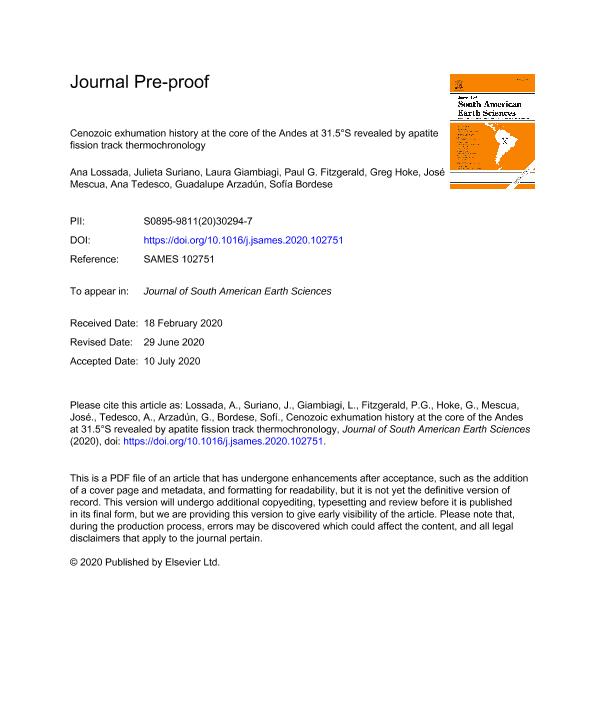Artículo
Cenozoic exhumation history at the core of the Andes at 31.5°S revealed by apatite fission track thermochronology
Lossada, Ana Clara ; Suriano, Julieta
; Suriano, Julieta ; Giambiagi, Laura Beatriz
; Giambiagi, Laura Beatriz ; Fitzgerald, Paul G.; Hoke, Gregory; Mescua, Jose Francisco
; Fitzgerald, Paul G.; Hoke, Gregory; Mescua, Jose Francisco ; Tedesco, Ana; Arzadún, Guadalupe
; Tedesco, Ana; Arzadún, Guadalupe ; Bordese, Sofía
; Bordese, Sofía
 ; Suriano, Julieta
; Suriano, Julieta ; Giambiagi, Laura Beatriz
; Giambiagi, Laura Beatriz ; Fitzgerald, Paul G.; Hoke, Gregory; Mescua, Jose Francisco
; Fitzgerald, Paul G.; Hoke, Gregory; Mescua, Jose Francisco ; Tedesco, Ana; Arzadún, Guadalupe
; Tedesco, Ana; Arzadún, Guadalupe ; Bordese, Sofía
; Bordese, Sofía
Fecha de publicación:
11/2020
Editorial:
Pergamon-Elsevier Science Ltd
Revista:
Journal of South American Earth Sciences
ISSN:
0895-9811
Idioma:
Inglés
Tipo de recurso:
Artículo publicado
Clasificación temática:
Resumen
The Andes at ~31°-32°S lie above the Chilean-Pampean flat slab zone (~27–33°S), where several morphostructural units developed resulting in a large orogenic width. The core of the Andes is composed of the La Ramada fold-and-thrust belt in Principal Cordillera and the basement blocks of Frontal Cordillera. While rock uplift of these blocks has been broadly constrained to the middle Miocene based on structural and provenance studies, thermochronologic approaches with the potential to directly constrain the timing and amount of exhumation have not been exploited until recently. Apatite fission track data from a ~1 km vertical profile collected within the Carboniferous Pico Los Sapos Batholith in the High Andes at 31.5°S places some constraints on the thermal evolution of the region since the Paleocene. The age-elevation profile combined with inverse thermal modeling and previous AHe thermochronology, indicates an episodic cooling/exhumation history. Rocks cooled rapidly in the early Cenozoic (ca. 65-55 Ma), followed by a period of relative thermal and tectonic stability when residence in an apatite partial annealing zone (PAZ) from at least ~52 Ma to ca.15 Ma, followed by final rapid cooling beginning ca. 15 Ma. We interpret early Cenozoic and middle Miocene rapid cooling events as to be related to erosional exhumation during Andean contractional phases, associated with thrust activity along the Mondaquita Fault. The age-elevation profile is partially duplicated, with upper samples being offset ~500 m due to back-thrusting since the late Miocene. The preservation of part of an exhumed PAZ indicates 3–5 km of exhumation since the onset of rapid cooling/exhumation at ~15 Ma. Although evidence for an early Cenozoic compressional phase in the High Andes at this latitude is scarce, the occurrence of a regional K-T (~65 Ma) unconformity supports our results. The Eocene Inca phase, registered north of 30°S, on the other hand, is not shown in our thermochronological data, suggesting that this tectonic phase did not affect the core of the Andes south of this latitude. Independent geological evidence both from the hinterland (structural, geochemical and thermochronological analyses) and foreland (provenance studies) corroborate our findings of a middle Miocene deformational event in the core of the Andes at 31.5°S.
Archivos asociados
Licencia
Identificadores
Colecciones
Articulos(IANIGLA)
Articulos de INST. ARG. DE NIVOLOGIA, GLACIOLOGIA Y CS. AMBIENT
Articulos de INST. ARG. DE NIVOLOGIA, GLACIOLOGIA Y CS. AMBIENT
Articulos(IDEAN)
Articulos de INSTITUTO DE ESTUDIOS ANDINOS "DON PABLO GROEBER"
Articulos de INSTITUTO DE ESTUDIOS ANDINOS "DON PABLO GROEBER"
Citación
Lossada, Ana Clara; Suriano, Julieta; Giambiagi, Laura Beatriz; Fitzgerald, Paul G.; Hoke, Gregory; et al.; Cenozoic exhumation history at the core of the Andes at 31.5°S revealed by apatite fission track thermochronology; Pergamon-Elsevier Science Ltd; Journal of South American Earth Sciences; 103; 11-2020; 1-36
Compartir
Altmétricas



